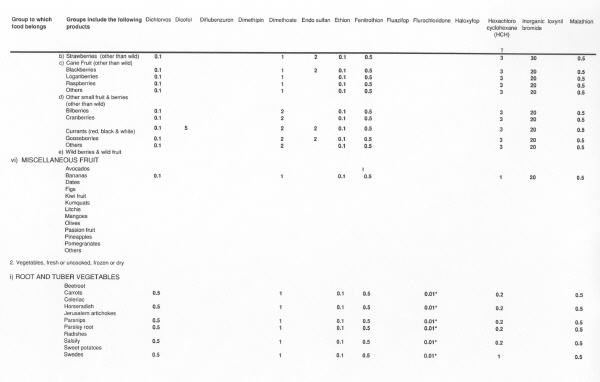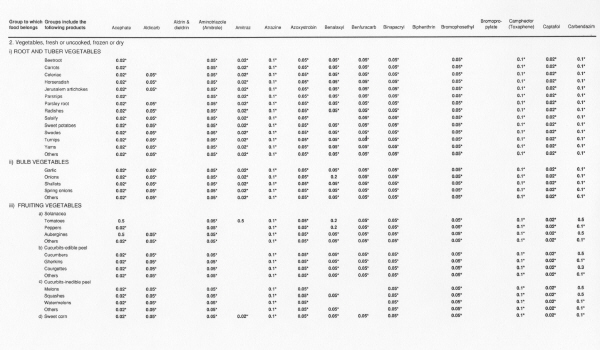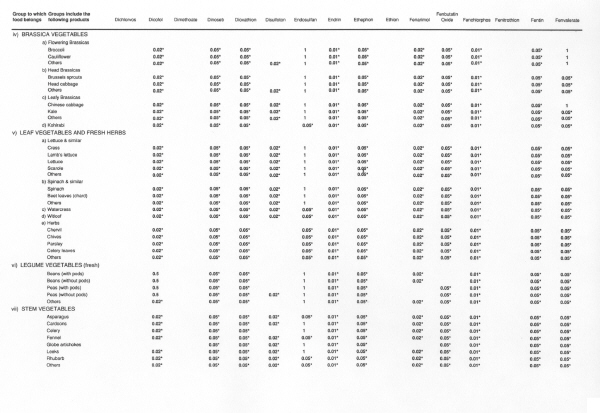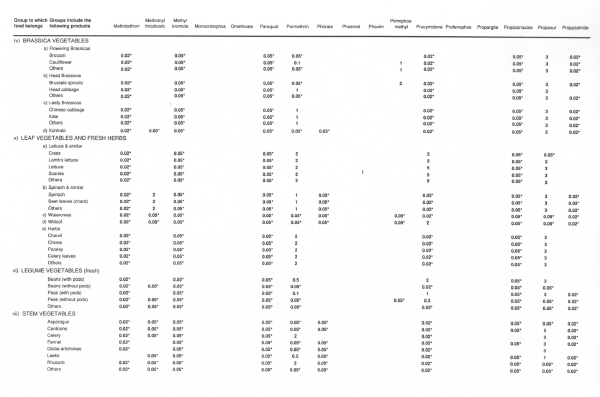- Latest available (Revised)
- Point in Time (01/02/2000)
- Original (As made)
The Pesticides (Maximum Residue Levels in Crops, Food and Feeding Stuffs) (Scotland) Regulations 2000
You are here:
- Scottish Statutory Instruments
- 2000 No. 22
- Schedules only
- Show Geographical Extent(e.g. England, Wales, Scotland and Northern Ireland)
- Show Timeline of Changes
More Resources
Changes over time for: The Pesticides (Maximum Residue Levels in Crops, Food and Feeding Stuffs) (Scotland) Regulations 2000 (Schedules only)
Alternative versions:
- 01/02/2000- Amendment
- 01/02/2000
Point in time
Status:
Point in time view as at 01/02/2000.
Changes to legislation:
There are outstanding changes not yet made by the legislation.gov.uk editorial team to The Pesticides (Maximum Residue Levels in Crops, Food and Feeding Stuffs) (Scotland) Regulations 2000. Any changes that have already been made by the team appear in the content and are referenced with annotations.![]()
Changes to Legislation
Changes and effects yet to be applied by the editorial team are only applicable when viewing the latest version or prospective version of legislation. They are therefore not accessible when viewing legislation as at a specific point in time. To view the ‘Changes to Legislation’ information for this provision return to the latest version view using the options provided in the ‘What Version’ box above.
Regulation 2
SCHEDULE 1S
| Column 1 | Column 2 |
|---|---|
| Pesticide | Residues |
| Acephate | Acephate |
| Aldrin & Dieldrin | singly or combined, expressed as dieldrin (HEOD) |
| 2-Aminobutane | 2-aminobutane |
| Aminotriazole | Aminotriazole |
| Atrazine | Atrazine |
| Azinphos-methyl | azinphos-methyl |
| Benalaxyl | Benalaxyl |
| Benfuracarb | Benfuracarb |
| Binapacryl | Binapacryl |
| Biphenthrin | Biphenthrin |
| Bitertanol | Bitertanol |
| Bromophos-ethyl | bromophos-ethyl |
| Camphechlor (Toxaphene) | camphechlor (toxaphene) |
| Captafol | Captafol |
| Captan | Captan |
| Carbaryl | Carbaryl |
| Carbendazim, Benomyl and Thiophanate-methyl | carbendazim, benomyl and thiophanate-methyl (expressed as carbendazim) |
| Carbon disulphide | carbon disulphide |
| Carbon Tetrachloride | carbon tetrachloride |
| Carbofuran | sum of carbofuran and 3-hydroxy-carbofuran, expressed as carbofuran |
| Carbophenothion | sum of carbophenothion, its sulphoxide and its sulphone, expressed as carbophenothion |
| Carbosulfan | Carbosulfan |
| Cartap | Cartap |
| Chlordane | (1)for products of animal origin: sum ofcis- andtrans-isomers and oxychlordane expressed as chlordane; (2)for cereals, fruit and vegetables: sum ofcis- andtrans- isomers expressed as chlordane |
| Chlorfenvinphos | sum of E-and Z-isomers of chlorfenvinphos |
| Chlormequat | Chlormequat |
| Chlorothalonil | Chlorothalonil |
| Chlorobenzilate | Chlorobenzilate |
| Chlorpyrifos | Chlorpyrifos |
| Chlorpyrifos-methyl | chlorpyrifos-methyl |
| Cyfluthrin | cyfluthrin, including other mixed isomeric constituents (sum of isomers) |
| Cypermethrin | cypermethrin (sum of isomers) |
| Daminozide | sum of daminozide and 1,1-dimethyl-hydrazine expressed as daminozide |
| DDT | sum of pp’-DDT, op’-DDT, pp’-DDE and pp’-TDE (DDD) expressed as DDT |
| Deltamethrin | Deltamethrin |
| Diazinon | Diazinon |
| 1,2-Dibromoethane | 1,2-dibromoethane |
| Dichlofluanid | Dichlofluanid |
| Dichlorvos | Dichlorvos |
| Dichlorprop | dichlorprop (including dichlorprop P) |
| Dicofol | Dicofol |
| Diflubenzuron | Diflubenzuron |
| Dimethipin | Dimethipin |
| Dimethoate | Dimethoate |
| Dinoseb | Dinoseb |
| Dioxathion | Dioxathion |
| Disulfoton | sum of disulfoton, disulfoton sulphoxide and disulfoton sulphone expressed as disulfoton |
| Endosulfan | sum of alpha-and beta-isomers and of endosulfan sulphate, expressed as endosulfan |
| Endrin | Endrin |
| Ethephon | Ethephon |
| Ethion | Ethion |
| Etrimfos | Etrimfos |
| Fenarimol | Fenarimol |
| Fenbutatin oxide | fenbutatin oxide |
| Fenchlorphos | fenchlorphos (sum of fenchlorphos and fenchlorphos oxon, expressed as fenchlorphos) |
| Fenitrothion | Fenitrothion |
| Fentin | fentin expressed as triphenyltin cation |
| Fenvalerate | fenvalerate (sum of isomers) |
| Fluazifop | fluazifop and esters (including conjugates) of fluazifop, expressed as free acid |
| Flurochloridone | Flurochloridone |
| Furathiocarb | Furathiocarb |
| Glyphosate | Glyphosate |
| Haloxyfop | haloxyfop and esters (including conjugates) of haloxyfop, expressed as free acid |
| Hexachlorobenzene (HCB) | Hexachlorobenzene |
| Hexachlorocyclohexane (HCH) | Hexachlorocyclohexane (HCH) alpha, beta and gamma isomers individually or summed as in Schedule 2 |
| Heptachlor | sum of heptachlor and heptachlor epoxide, expressed as heptachlor |
| Hydrogen cyanide | cyanides expressed as hydrogen cyanide |
| Hydrogen phosphide | phosphides expressed as hydrogen phosphide |
| Imazalil | Imazalil |
| Inorganic bromide | determined and expressed as total bromine from all sources |
| Ioxynil | Ioxynil |
| Iprodione | Iprodione |
| Lambda-cyhalothrin | lambda-cyhalothrin |
| Malathion | sum of malathion and malaoxon, expressed as malathion |
| Maleic hydrazide | maleic hydrazide |
| Maneb, Mancozeb, Metiram Propineb and Zineb | determined and expressed as carbon disulphide (CS2) |
| Mecarbam | Mecarbam |
| Mercury compounds | determined as total mercury and expressed as mercury |
| Metalaxyl | metalaxyl |
| Methacrifos | methacrifos |
| Methamidophos | methamidophos |
| Methyl bromide (bromomethane) | methyl bromide (bromomethane) |
| Mevinphos | sum ofcis- andtrans- mevinphos |
| Monocrotophos | monocrotophos |
| Omethoate | omethoate (from use of formothion, dimethoate and omethoate) |
| Paraquat | paraquat |
| Parathion | parathion |
| Parathion-methyl | parathion-methyl |
| Permethrin | permethrin (and sum of isomers) |
| Phorate | sum of phorate, its oxygen analogue and their sulfoxides and sulphones expressed as phorate |
| Phosalone | phosalone |
| Phosmet | phosmet |
| Phosphamidon | sum of phosphamidon (E-and Z-isomers) and N-desethylphosphamidon (E-and Z-isomers) expressed as phosphamidon |
| Pirimiphos-methyl | pirimiphos-methyl |
| Procymidone | procymidone |
| Propargite | propargite |
| Propiconazole | propiconazole |
| Propoxur | propoxur |
| Propyzamide | propyzamide |
| Pyrethrins | sum of pyrethrins I and II, cinerins I and II, jasmolins I and II |
| Quinalphos | quinalphos |
| Quintozene | sum of quintozene, pentachloroaniline and methyl pentachlorophenyl sulphide expressed as quintozene |
| Tecnazene | tecnazene |
| TEPP | TEPP |
| Thiabendazole | thiabendazole |
| Triazophos | triazophos |
| Trichlorfon | trichlorfon |
| Triforine | triforine |
| 2, 4, 5-T | 2, 4, 5-T |
| Vinclozolin | sum of vinclozolin and all metabolites containing 3, 5-dichloroaniline moiety, expressed as vinclozolin |
Regulation 3
SCHEDULE 2S
Regulation 6
SCHEDULE 3S
Note: The word 'fresh’ is taken to extend to products which have been chilled.
| Column 1 | Column 2 | Column 3 |
|---|---|---|
| Group of products | Products included in the groups | Part of product to which maximum residue levels apply |
1.Fruit, fresh, dried or uncooked, preserved by freezing, not containing added sugar: nuts | ||
(i)CITRUS FRUIT | Grapefruit Lemons Limes Mandarins (including clementines and similar hybrids) Oranges Pomelos Others | Whole Product. |
(ii)TREE NUTS (shelled or unshelled) | Almonds Brazil nuts Cashew nuts Chestnuts Coconuts Hazelnuts Macadamia nuts Pecans Pine nuts Pistachios Walnuts Others | Whole product after removal of shell. |
(iii)POME FRUIT | Apples Pears Quinces Others | Whole product after removal of stems. |
(iv)STONE FRUIT | Apricots Cherries Peaches (including nectarines and similar hybrids) Plums Others | Whole product after removal of stems. |
(v)BERRIES AND SMALL FRUIT | (a)Table and wine grapes Table grapes Wine grapes (b)Strawberries (other than wild) (c)Cane fruit (other than wild) Blackberries Dewberries Loganberries Raspberries Others (d)Other small fruit and berries (other than wild) Bilberries Cranberries Currants (red, black and white) Gooseberries Others (e)Wild berries and wild fruit | Whole product after removal of caps and stems (if any) and, in the case of currants, fruits with stems. |
(vi)MISCELLANEOUS FRUIT | Avocados Bananas Dates Figs Kiwi fruit Kumquats Litchis Mangoes Olives (table consumption){ Olives (oil extract) Passion fruit Pineapples Pomegranates Others | Whole fruit after removal of stems (if any) and in the case of pineapple, after removal of the crown. {Whole fruit after removal of stems (if any) after removal of soil (if any) by rinsing in running water. |
(i)ROOT AND TUBER VEGETABLES | Beetroot Carrots Celeriac Horseradish Jerusalem artichokes Parsnips Parsley root Radishes Salsify Sweet potatoes Swedes Turnips Yams Others | Whole product after removal of tops and adhering soil (if any) (removal of soil by rinsing in running water or by gentle brushing of the dry product). |
2.Vegetables, fresh or uncooked, frozen or dry (ii)BULB VEGETABLES | Garlic Onions Shallots Spring Onions Others | For dry onions, shallots and garlic: whole product after removal of easily detachable skin and soil (if any). Onions, shallots and garlic other than dry, spring onions: whole product after removal of roots and soil (if any). |
(iii)FRUITING VEGETABLES | (a)Solanacea Tomatoes Peppers Aubergines Others (b)Cucurbits-edible peel Cucumbers Gherkin Courgettes Others (c)Cucurbits-inedible peel Melons Squashes Watermelons Others | Whole product after removal of stems. |
(d)Sweet corn | Kernels or cobs without husks. | |
(iv)BRASSICA VEGETABLES | (a)Flowering brassicas Broccoli Cauliflower Others (b)Head brassicas Brussels sprouts Head cabbage Others (c)Leafy brassicas Chinese cabbage Kale Others | Product after removal of decayed leaves (if any). |
(d)Kohlrabi | Whole product after removal of tops and adhering soil (if any) (removal of soil by rinsing in running water or by gentle brushing of the dry product). | |
(v)LEAF VEGETABLES AND FRESH HERBS | (a)Lettuce and similar Cress Lamb’s lettuce Lettuce Scarole Others (b)Spinach and similar Spinach Beet leaves (chard) Others (c)Watercress (d)Witloof (e)Herbs Chervil Chives Parsley Celery leaves Others | Whole product after removal of decayed outer leaves, root and soil (if any). |
(vi)LEGUME VEGETABLES (FRESH) | Beans with pods Beans without pods Peas with pods Peas without pods Others | Whole product after removal of pods or with pods if they are intended to be eaten. |
(vii)STEM VEGETABLES | Asparagus Cardoons Celery Fennel Globe artichokes Leeks Rhubarb Others | Whole product after removal of decayed tissue and soil (if any); leeks and fennel: whole product after removal of roots and soil (if any). |
(viii)FUNGI | Mushrooms (other than wild) Wild Mushrooms | Whole product after removal of decayed tissue and soil (if any); leeks and fennel: whole product after removal of roots and soil (if any). |
3.Pulses | Beans Lentils Peas Others | Whole product. |
4.Oil seeds | Linseed Peanuts Poppy seed Rape seed Sesame seed Sunflower seed* Soya bean Others | Whole seed or kernel after removal of shell and husk, when possible. *Whole seed including shell, when present, and whole seed without shell, when shell is absent. |
5.Potatoes | Early potatoes Ware potatoes | Whole product after removal of soil (if any) (removal of soil by rinsing in running water or by gentle brushing of the dry product). |
6.Tea (dried leaves and stalks, fermented or otherwise, Camellia sinensis) | ||
| Whole product. | ||
7.Hops (dried), including hop pellets and unconcentrated powder | ||
| Whole product. | ||
8.Cereal grains | Wheat Rye Barley Oats Triticale Maize Rice Other cereals | Whole commodity without husk. |
9.Products of animal origin | Meat, fat and preparations of meat | Whole commodity (For fat soluble pesticides a portion of carcass fat is analysed and MRLs apply to carcass fat. |
| Milk | Whole commodity. | |
| Eggs | Whole egg whites and yolks combined after removal of shells. | |
10.Spices | Cumin seed Juniper berries Nutmeg Pepper, black and white Vanilla pods Others | Whole product. |
Regulation 7
SCHEDULE 4S REVOCATIONS
| Title | S.I. Number |
|---|---|
| The Pesticides (Maximum Residue Levels in Crops, Food and Feeding Stuffs) Regulations 1994 | S.I. 1994/1985. |
| The Pesticides (Maximum Residue Levels in Crops, Food and Feeding Stuffs) (Amendment) Regulations 1995 | S.I. 1995/1483. |
| The Pesticides (Maximum Residue Levels in Crops, Food and Feeding Stuffs) (Amendment) Regulations 1996 | S.I. 1996/1487 |
| The Pesticides (Maximum Residue Levels in Crops, Food and Feeding Stuffs) (Amendment) Regulations 1997 | S.I. 1997/567. |
| The Pesticides (Maximum Residue Levels in Crops, Food and Feeding Stuffs) (Amendment) Regulations 1998 | S.I. 1998/2922. |
| The Pesticides (Maximum Residue Levels in Crops, Food and Feeding Stuffs) (Amendment) Regulations 1999 | S.I. 1999/1109. |
Options/Help
Print Options
PrintThe Whole Instrument
PrintThe Schedules only
Legislation is available in different versions:
Latest Available (revised):The latest available updated version of the legislation incorporating changes made by subsequent legislation and applied by our editorial team. Changes we have not yet applied to the text, can be found in the ‘Changes to Legislation’ area.
Original (As Enacted or Made): The original version of the legislation as it stood when it was enacted or made. No changes have been applied to the text.
Point in Time: This becomes available after navigating to view revised legislation as it stood at a certain point in time via Advanced Features > Show Timeline of Changes or via a point in time advanced search.
See additional information alongside the content
Geographical Extent: Indicates the geographical area that this provision applies to. For further information see ‘Frequently Asked Questions’.
Show Timeline of Changes: See how this legislation has or could change over time. Turning this feature on will show extra navigation options to go to these specific points in time. Return to the latest available version by using the controls above in the What Version box.
More Resources
Access essential accompanying documents and information for this legislation item from this tab. Dependent on the legislation item being viewed this may include:
- the original print PDF of the as enacted version that was used for the print copy
- lists of changes made by and/or affecting this legislation item
- confers power and blanket amendment details
- all formats of all associated documents
- correction slips
- links to related legislation and further information resources
Timeline of Changes
This timeline shows the different points in time where a change occurred. The dates will coincide with the earliest date on which the change (e.g an insertion, a repeal or a substitution) that was applied came into force. The first date in the timeline will usually be the earliest date when the provision came into force. In some cases the first date is 01/02/1991 (or for Northern Ireland legislation 01/01/2006). This date is our basedate. No versions before this date are available. For further information see the Editorial Practice Guide and Glossary under Help.
More Resources
Use this menu to access essential accompanying documents and information for this legislation item. Dependent on the legislation item being viewed this may include:
- the original print PDF of the as made version that was used for the print copy
- correction slips
Click 'View More' or select 'More Resources' tab for additional information including:
- lists of changes made by and/or affecting this legislation item
- confers power and blanket amendment details
- all formats of all associated documents
- links to related legislation and further information resources























































